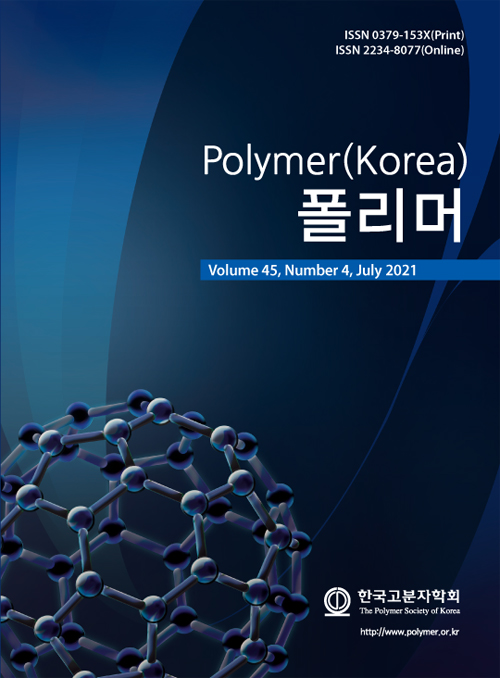- Biopolyurethane Foam Prepared with Commercial Microcrystalline Cellulose-added Polyol Obtained from Liquefaction of a Lignocellulosic Biomass and Isocyanate, and Its Optimization
Department of Chemical Engineering, Daegu University, Gyeongbuk 38453, Korea
- 상업용 Microcrystalline Cellulose를 부가한 리그노셀루로식 액화 폴리올로부터 바이오폴리우레탄 폼의 제조 및 최적화
대구대학교 공과대학 화학공학과
Reproduction, stored in a retrieval system, or transmitted in any form of any part of this publication is permitted only by written permission from the Polymer Society of Korea.
The density, cream time, rise time and compressive strength of bio polyurethane foams (MCC-bio PU foam) prepared using commercial microcrystalline cellulose (MCC)-added lignocellulosic liquefied polyol according to central composite design (CCD) in this study, were applied as dependent variables for the preparation of MCC-bio PU foam, and were regressively analyzed by response surface methodology to seek the optimum process conditions of the added amount of MCC, the mass ratio between liquefied biopolyol and PEG and the amount of distilled water. According to SEM observation, cells in the MCC-bio PU foam were observed smaller, more developed and more intact than those in bio-polyurethane foams (bio-PU foam) prepared without the addition of commercial MCC according to Lee et al. (Polym. Korea 2019, 43, 899-913). However, the cell morphology of the MCC-bio PU foam was observed so elongated to look like an ellipse in such process conditions that relatively more amount of commercial MCC was added than that added in the rest of process conditions in the experimental plan according to CCD.
상업용 microcrystalline cellulose(MCC)를 부가한 리그노셀루로식 액화 폴리올로부터 바이오 폴리우레탄 폼(MCC-바이오 PU 폼)을 central composite design(CCD) 실험계획에 따른 각각의 실험조건에서 제조하였다. 제조된 MCC-바이오 PU 폼의 밀도, cream time, rise time 및 압축강도를 MCC-바이오 PU 폼 제조의 종속변수로 하여 각각에 대한 회귀분석을 반응표면분석법으로 수행하여서, 공정변수인 상업용 MCC 부가량, 액화폴리올 대 PEG 양의 비 및 증류수 양의 적정조건을 도출하였다. MCC-바이오 PU 폼의 SEM 분석 결과로서, 본 연구에서 제조한 MCC-바이오 PU 폼의 셀 크기가 상업용 MCC가 부가되지 않은 경우의 바이오 PU 폼보다 전반적으로 더 작고, 셀 상태가 더 발달하고 양호함이 관찰되었다. 그러나 상업용 MCC 양이 상대적으로 많이 부가된 조건에서는 MCC-바이오 PU 폼의 셀 모폴로지는 길쭉한 타원형으로 관찰되었다.
Keywords: microcrystalline cellulose-bio polyurethane foam, commercial microcrystalline cellulose, lignocellulosic liquefaction, liquefied polyol, lignocellulosic biomass.
- Polymer(Korea) 폴리머
- Frequency : Bimonthly(odd)
ISSN 0379-153X(Print)
ISSN 2234-8077(Online)
Abbr. Polym. Korea - 2023 Impact Factor : 0.4
- Indexed in SCIE
 This Article
This Article
-
2021; 45(4): 568-580
Published online Jul 25, 2021
- 10.7317/pk.2021.45.4.568
- Received on Feb 26, 2021
- Revised on Mar 19, 2021
- Accepted on Mar 29, 2021
 Correspondence to
Correspondence to
- Kwang-Hee Lim
-
Department of Chemical Engineering, Daegu University, Gyeongbuk 38453, Korea
- E-mail: khlim@daegu.ac.kr










 Copyright(c) The Polymer Society of Korea. All right reserved.
Copyright(c) The Polymer Society of Korea. All right reserved.